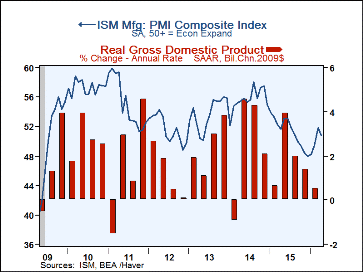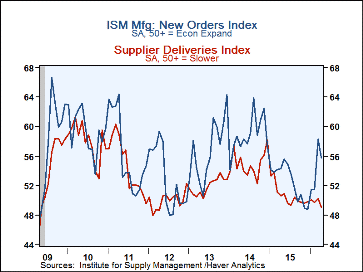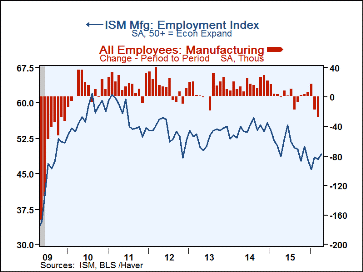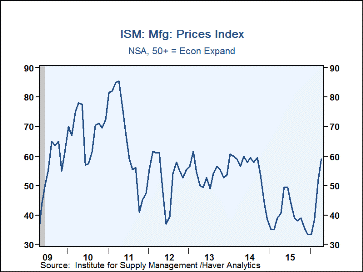 Global| May 02 2016
Global| May 02 2016Manufacturing ISM Index Eases, but Pricing Firms
by:Tom Moeller
|in:Economy in Brief
Summary
The ISM Composite Index of manufacturing activity posted a sharp decline to 50.8 during April. The move reversed much of a rise to an unrevised 51.8 in March, and disappointed expectations for 51.3 in the Action Economics Forecast [...]
The ISM Composite Index of manufacturing activity posted a sharp decline to 50.8 during April. The move reversed much of a rise to an unrevised 51.8 in March, and disappointed expectations for 51.3 in the Action Economics Forecast Survey. The data from the Institute for Supply Management (ISM) are diffusion indexes where a reading above 50 indicates an increase in activity. Despite last month's decline, the index remained above the break-even of 50, up from the December low of 48.0. During the last ten years there has been a 74% correlation between the level of the ISM index and the q/q changed in real GDP.
Declines in the component series were broad-based last month, and led by new orders to 55.8 from 58.3. Nevertheless, the index continued to show expansion of orders for the fifth straight month. Declines in other components included inventories to 45.5 from 47.0, indicating that inventory control remained strict. The decline in the vendor performance series to 49.1 from 50.2 suggested that product delivery speeds quickened significantly. The production series fell to 54.2 from 55.3, but remained near its recent high.
Improvement in the employment series to 49.2 from 48.1 suggested that cutbacks in employment eased to the slowest rate since jobs increased in November. During the last ten years, there has been an 88% correlation between the figure and the m/m change in factory sector payrolls.
The prices paid index also improved sharply to 59.0 from 51.5. The rise left the index at the highest level since September 2014. Twenty-eight percent of industries reported higher prices while 10% reported that prices fell.
Other component series, not included in the composite reading, showed mixed performance. The export figure improved to 52.5, the highest level since November 2014. The imports index of 50 also was up significantly from the December low. The order backlog index eased slightly to 50.5, but remained up sharply from the September low.
The figures from the Institute for Supply Management can be found in Haver's USECON database. The expectations number is in Haver's AS1REPNA database.
| ISM Mfg (SA) | Apr | Mar | Feb | Apr '15 | 2015 | 2014 | 2013 |
|---|---|---|---|---|---|---|---|
| Composite Index | 50.8 | 51.8 | 49.5 | 51.6 | 51.3 | 55.6 | 53.8 |
| New Orders | 55.8 | 58.3 | 51.5 | 54.3 | 52.6 | 58.9 | 56.8 |
| Production | 54.2 | 55.3 | 52.8 | 55.1 | 53.5 | 59.2 | 57.5 |
| Employment | 49.2 | 48.1 | 48.5 | 48.6 | 51.0 | 54.4 | 53.1 |
| Supplier Deliveries | 49.1 | 50.2 | 49.7 | 50.6 | 50.7 | 55.0 | 51.9 |
| Inventories | 45.5 | 47.0 | 45.0 | 49.5 | 49.0 | 50.8 | 49.4 |
| Prices Paid Index (NSA) | 59.0 | 51.5 | 38.5 | 40.5 | 39.8 | 55.6 | 53.8 |
Tom Moeller
AuthorMore in Author Profile »Prior to joining Haver Analytics in 2000, Mr. Moeller worked as the Economist at Chancellor Capital Management from 1985 to 1999. There, he developed comprehensive economic forecasts and interpreted economic data for equity and fixed income portfolio managers. Also at Chancellor, Mr. Moeller worked as an equity analyst and was responsible for researching and rating companies in the economically sensitive automobile and housing industries for investment in Chancellor’s equity portfolio. Prior to joining Chancellor, Mr. Moeller was an Economist at Citibank from 1979 to 1984. He also analyzed pricing behavior in the metals industry for the Council on Wage and Price Stability in Washington, D.C. In 1999, Mr. Moeller received the award for most accurate forecast from the Forecasters' Club of New York. From 1990 to 1992 he was President of the New York Association for Business Economists. Mr. Moeller earned an M.B.A. in Finance from Fordham University, where he graduated in 1987. He holds a Bachelor of Arts in Economics from George Washington University.










